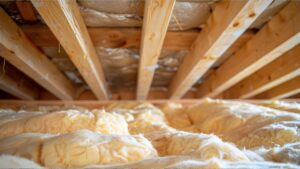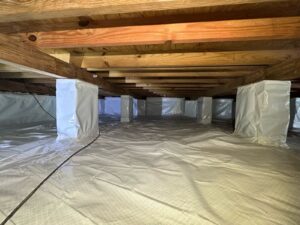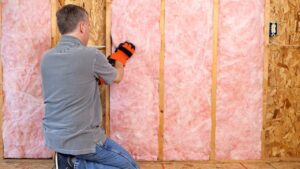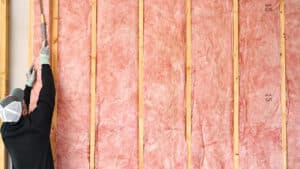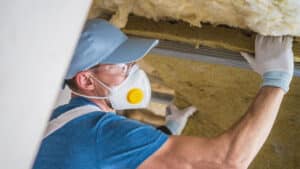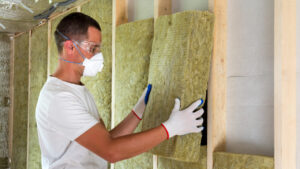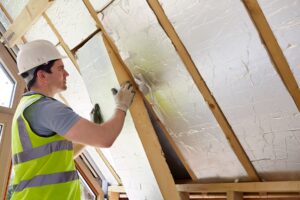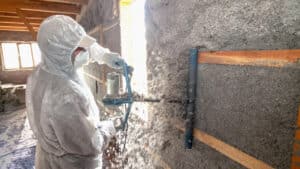Stepping into a tranquil, noise-free home is like entering a peaceful oasis amidst the chaos of the outside world.
Attic insulation doesn’t just keep your house warm; it plays a critical role in making that serenity possible by blocking and absorbing sound.
By understanding how different materials work to prevent noise from penetrating your living spaces, you can significantly enhance the quality of your indoor environment.
Whether it’s the clamor from airplanes overhead or the hum of daily life outside, properly insulated attics can dial down the intrusion.
Keep reading to discover how attic insulation could dampen noise in your home. When searching for ‘insulation companies near me’ in Virginia Beach, it’s important to consider not just proximity, but also expertise in sound reduction techniques for optimal results.
Understanding How Attic Insulation Affects Sound Transmission
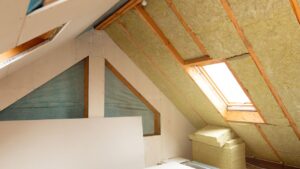
Attic insulation is more than just thermal insulation – it also plays a critical role in mitigating noise pollution within the home. This means that while it prevents heat transfer between indoor and outdoor environments, it also acts as a barrier against external sounds and reduces the transmission of internal noises between floors.
Understanding how sound waves travel through a house unveils the attic’s significant impact on sound propagation, emphasizing its potential as an effective means to control noise.
Exploring the fundamentals of soundproofing versus sound absorption reveals the mechanisms through which insulation materials inhibit sound transmission, offering homeowners a strategic approach to enhance the acoustical comfort of their homes. For homeowners in areas like the coordinates 36.8339607007020000, -75.9739134105520000, where coastal conditions can affect sound propagation, understanding these principles is particularly crucial for effective noise reduction.
Identifying Different Types of Noise in Your Home
Identifying the various noises present in your home is the first step towards a more peaceful environment. Within any household, noise pollution can emerge from both external and internal sources. These include the roar of traffic, the rumblings of construction, and sounds generated indoors, such as footsteps, conversations, children, and even the hum of home appliances.
Understanding these different types of noise is crucial for determining the appropriate strategy when building insulation:
– External noise from traffic, construction, and nature
– Internal structural noises like footsteps and plumbing sounds
– Indoor ambient sounds generated from appliances and HVAC systems
The Role of the Attic in Sound Propagation
The attic can either dampen or amplify the noise in your house. Due to its location at the top of the house and its proximity to the roof and exterior walls, the attic can either absorb outdoor noises before they permeate the rest of the home or, conversely, allow sound waves from within the house to bounce and amplify.
As such, equipping the attic with proper insulation is a strategic move that effectively reduces noise pollution, enhancing the overall tranquility of the living space.
– Insulation acts as a sound barrier, impeding the flow of external noises into the home.
– By absorbing sound waves, attic insulation can prevent internal sounds from echoing and amplifying.
– The materials used in attic insulation also play a significant role in its effectiveness in sound reduction.
Basics of Soundproofing Versus Sound Absorption
There is a difference between soundproofing and sound absorption. While soundproofing involves creating barriers to prevent noise from entering or leaving a space, sound absorption aims to remove echo and reverberation by trapping sound waves within insulation materials.
Homeowners seeking a serene environment often leverage a combination of these techniques in their attic to minimize both external noise intrusion and internal sound propagation.
The Science Behind Noise Reduction Coefficient (NRC)
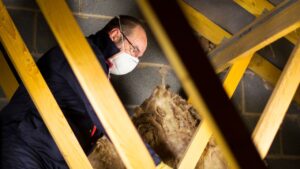
The Noise Reduction Coefficient (NRC) is an important piece of the conversation around noise reduction.
This measurement gauges the effectiveness of insulation materials in absorbing sound, thus playing a pivotal role in enhancing the acoustic comfort of any living space.
Exploring what NRC is, how it’s measured, and why its importance cannot be overstated. Through this, homeowners can make informed decisions when selecting attic insulation.
Interpreting NRC ratings accurately is crucial for achieving desired noise reduction outcomes, enabling a quieter, more serene home environment by using building insulation materials tailored to specific acoustic needs.
What Is Noise Reduction Coefficient?
The Noise Reduction Coefficient (NRC) is a critical measure that gauges the ability of insulation material to absorb sound. It is expressed as a decimal number between 0 and 1, where higher values signify greater effectiveness in sound absorption. Some materials may have higher than 1 NRC value depending on the density of the material.
This coefficient is essential for homeowners investing in attic insulation with the goal of improving the acoustical comfort of their living spaces.
How NRC Is Measured and Its Importance
The Noise Reduction Coefficient (NRC) is measured through a process where building insulation materials are subjected to a series of sound frequencies to observe their sound absorption capabilities. This measurement is crucial: it informs homeowners and builders about which materials will significantly enhance the tranquility of living space by absorbing sound effectively.
With an accurate understanding of a material’s NRC rating, individuals can make informed decisions, ensuring their attic insulation meets their noise reduction needs and improves the overall acoustical comfort of their home.
– Materials are tested across different sound frequencies to determine their NRC.
– The process provides vital information on how well insulation absorbs sound.
– Understanding NRC ratings helps select the most effective materials for sound reduction.
So, how do the different insulation materials compare in terms of NRC?
Here is a table showing the different types of insulation materials and their typical Noise Reduction Coefficient (NRC) ratings:
| Insulation Material | Noise Reduction Coefficient (NRC) |
|---|---|
| Mineral Wool | 0.95 - 1.05 |
| Fiberglass insulation | 0.9 - 0.95 |
| Spray Foam insulation | 0.70 - 0.75 |
| Cellulose Insulation | 0.50 - 0.75 |
The higher the value, the better the material is in noise reduction. Usually, a 0 NRC value means the insulation material reflects sound (radiant barriers) instead of absorbing it.
Comparing Soundproofing Qualities of Popular Insulation Materials

Exploring the relationship between attic insulation and its ability to minimize noise leads us directly to a comparison of the most commonly used building insulation materials.
These include:
– Mineral wool, famous for its noise reduction and fire resistance capabilities
– Fiberglass insulation
– Spray foam insulation, which offers impressive sound reduction benefits
– Cellulose insulation, celebrated for its sound-absorbing properties
Each material brings a unique set of advantages to the soundproofing equation, demonstrating that the choice of insulation greatly influences the acoustic environment of a home.
Let’s dive deeper into the characteristics of these materials to assist homeowners in selecting the right one for their attic. This helps to achieve the optimal balance between air conditioning and sound reduction.
Mineral Wool Soundproofing Capabilities
Mineral wool, also known as rock wool or slag wool, is an inorganic insulation material made from natural rock or slag. It is an excellent choice for attic insulation due to its superior acoustics and superior thermal properties. In fact, with a noise reduction coefficient of 0.95 to 1.05, it stands to be the best insulation material when it comes to soundproofing your house. Mineral wool is great at sound absorption, stopping most noise.
Additionally, mineral wool is highly resistant to fire, moisture, and mold, making it a durable and long-lasting option. Its porous structure efficiently traps air pockets, providing excellent sound absorption and reducing noise transfer between floors.
Mineral wool is also an eco-friendly insulation material as it is made from abundant natural resources and can be recycled at the end of its lifespan. With its versatility and exceptional insulating capabilities, mineral wool is a popular choice for homeowners seeking effective attic insulation solutions.
Fiberglass Insulation and Noise Control
Fiberglass batt insulation stands out for its noise control capabilities, effectively dampening sound by disrupting sound waves as they pass through its dense fibrous structure. This material is especially efficient in attics, where it acts as a barrier to both external noises, such as traffic, and internal sounds between floors. This way, it significantly enhances the quietness of a home’s living environment. Also, it is easy to install as it’s made to comply with even the most standard joist.
In other words, fiberglass is among the best insulation materials, whether you are soundproofing your attic, basement, or even your entertainment room. With an NRC value between 0.9 and 0.95, fiberglass is quite effective in dampening or absorbing both external and interior noises in your home.
Efficacy of Spray Foam Insulation for Sound Reduction
The efficacy of spray foam insulation goes beyond its well-known energy-saving properties; it also plays a crucial role in sound reduction within homes. By expanding to fill gaps and creating a tight seal, spray foam insulation significantly reduces the pathways through which sound and vibrations can travel.
Combining its high NRC rating of 0.7 to 0.75 with its versatility to fill the gaps makes it a very versatile insulation type.
Cellulose Insulation’s Sound Absorbing Properties
Cellulose insulation is renowned for its sound-absorbing properties, making it an integral part of creating a quieter home. Composed of recycled paper fibers, it is dense enough to disrupt the path of sound waves, significantly reducing noise transmission through attic spaces.
This material not only helps in muting external noises but also plays a crucial role in damping sounds originating from within the house, such as conversations or the operation of household appliances. It has an NRC value of 0.5 to 0.75 based on the density of the material, meaning that it is above average.
– Mineral wool has the highest NRC, is fireproof, and is made from organic materials.
– Spray foam insulation seals gaps tightly, curbing the movement of sound and enhancing indoor tranquility.
– Fiberglass insulation disrupts sound waves with its dense fibrous structure, countering both external and internal noises.
– Cellulose insulation, with its heavy recycled paper composition, excels in absorbing sound, making it an excellent choice for homeowners seeking peace and quiet.
In neighborhoods like Rudee Heights, where a mix of residential and commercial areas can create varied noise profiles, choosing the right insulation material is essential for maintaining a peaceful home environment. Ultimately, mineral wool emerges as the winner when gauging soundproofing capabilities for insulation materials, with an NRC rating of up to 1.05. However, you also have to consider other factors like the materials used (organic or not) or the materials’ versatility, which allows its use in various situations, such as soundproofing your basement or drywall.
Designing Your Attic for Optimal Sound Reduction
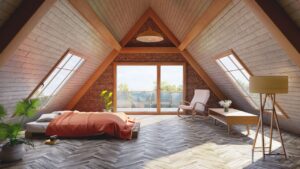
When designing your attic with sound reduction in mind, it’s critical to focus on not only the choice of insulation but also how it’s installed.
The strategic placement of insulation plays a pivotal role in dampening intrusive noises, whether they come from busy streets or the hum of daily life inside your own home.
Achieving comprehensive coverage within your attic space is essential to creating a serene environment, effectively sealing off any nooks where sound might penetrate.
Additionally, pinpointing and fortifying common sound leaks ensures a solid barrier against noise pollution.
This approach underscores the dual importance of material choice and precision in installation for homeowners aiming to enhance their living space’s tranquility.
Strategic Placement of Insulation for Sound Dampening
To maximize the sound-dampening potential of attic insulation, strategic placement is crucial. Key areas such as the floor, the walls adjacent to noisy areas, and the ceiling right beneath the roof should be prioritized to create a comprehensive sound barrier. This approach is especially beneficial for homes near popular areas like Resort Beach, where external noise from tourists and activities can be a concern.
This methodical approach ensures that sound waves originating from both inside and outside the home are effectively blocked or absorbed before they can infiltrate the living spaces below.
| Location in Attic | Sound Dampening Strategy | Expected Outcome |
|---|---|---|
| Floor | Evenly distribute high-density insulation | Reduce noise transfer from outside and between floors |
| Walls Adjacent to Noisy Areas | Apply extra insulation layers | Block external noise sources such as traffic |
| Ceiling beneath Roof | Incorporate insulation with a high NRC rating | Absorb airborne and impact noises from above |
Real-Life Benefits of Sound-Dampening Attic Insulation

Adding sound-dampening attic insulation goes beyond controlling noise; it enhances privacy and comfort in residential spaces.
This strategic addition doesn’t just mute external clamor but also safeguards intimate moments and conversations, vital to any living space.
The resulting tranquility has profound implications for health and well-being, creating a calm oasis that buffers the stressors of outside noise pollution.
Choosing the Right Professionals for Attic Noise Insulation in Hampton Roads
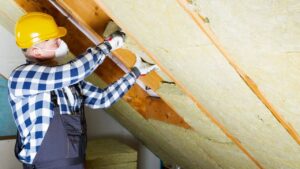
Selecting the right attic insulation professionals for sound dampening in the Virginia area, including Hampton Roads, is crucial for optimal acoustic performance and long-lasting results. Here are some key considerations:
– Expertise and Experience: Look for contractors specializing in attic insulation and soundproofing. They should have a deep understanding of acoustic principles, insulation materials, and installation techniques specific to noise reduction.
– Material Selection: Inquire about the insulation materials they recommend for sound dampening. Fiberglass, cellulose, and mineral wool are popular choices, each with unique acoustic properties. – Experienced contractors can guide you toward the most effective solution for your needs and budget.
– Installation Methods: Proper installation is vital for maximizing sound insulation. Reputable contractors should employ techniques such as air sealing, vapor barrier installation, and proper insulation density to minimize sound transfer between floors.
– Customer Reviews: Read online reviews and seek recommendations from friends, family, or neighbors who have had successful attic insulation projects for sound reduction. Positive testimonials can provide valuable insights into a contractor’s workmanship and customer service.
– Guarantees and Warranties: Inquire about the warranties and guarantees offered on materials and labor. Reputable contractors should stand behind their work and provide assurances against defects or failures.
By considering these factors, you can confidently select the right attic insulation professionals in the Hampton Roads area to effectively dampen unwanted noise and create a more peaceful living environment. When selecting an insulation contractor in Virginia Beach, look for those familiar with local conditions, such as those affecting homes near intersections like High Point Ave and Arctic Ave, where traffic noise might be a particular concern.
Don’t settle for subpar attic insulation and sound dampening. Choose the experts at Universal Insulation Doctor for unmatched professionalism and results in the Hampton Roads area. With years of experience, top-quality materials, and a commitment to customer satisfaction, they are the go-to choice for homeowners seeking superior acoustic comfort and energy conservation. Attain all these benefits of upgrading your attic insulation in Virginia Beach home
They specialize in new insulation installation, insulation removal, additional insulation, new crawl space insulation, and sanitizing/disinfectant treatment.
Contact them today for a free consultation.
FAQ
How long does attic insulation last?
Attic insulation can last for several decades, typically between 20-30 years, depending on the type of material used and the quality of installation. However, its effectiveness may diminish over time, necessitating periodic inspection and potential replacement. Proper maintenance and avoiding moisture buildup can help extend its lifespan.
What insulation is best for soundproofing?
Mineral wool or rock wool insulation is considered one of the best options for soundproofing due to its excellent sound-absorbing properties and density. Cellulose insulation is another good choice for reducing noise transfer. Fiberglass insulation, while effective for thermal insulation, may not provide as much sound dampening as denser materials.
Which building insulation is best for soundproofing?
The best building insulation depends on your specific needs and priorities, such as thermal efficiency, soundproofing, moisture resistance, and budget. Blown-in cellulose and fiberglass batts are popular choices for their affordability and ease of installation, while spray foam insulation offers superior air sealing and insulating properties but at a higher cost.
However, when using the NRC ratings, mineral wool takes the day with a noise reduction coefficient of up to 1.05.
Who can insulate my attic?
Professional insulation contractors like Universal Insulation Doctor are the recommended option for attic insulation projects. They have the expertise, equipment, and knowledge to ensure proper installation, safety protocols, and adherence to building codes. DIY attic insulation can be challenging and may compromise its effectiveness if not done correctly.
Does attic insulation stop noise pollution?
Yes, attic insulation can significantly reduce noise transfer between floors, providing improved soundproofing and acoustic comfort within your home. The insulation material's density, thickness, and installation quality all contribute to its noise-reducing capabilities. Properly installed attic insulation can effectively dampen airborne and impact noise, creating a quieter living environment.
Does insulation stop pest infestations?
Insulation does not directly prevent pest infestations. However, properly installed insulation can help seal off potential entry points and make the attic less appealing to pests, such as termites and rodents, by reducing moisture and food sources. We use a material called PestGuard which deters animals and insects from burrowing into the insulation. It is hyper-effective.
In other words, regularly inspecting and maintaining the insulation can contribute to deterring pests from nesting in the attic space. This saves you from pest control costs that could easily amount to hundreds, if not thousands, of dollars.

